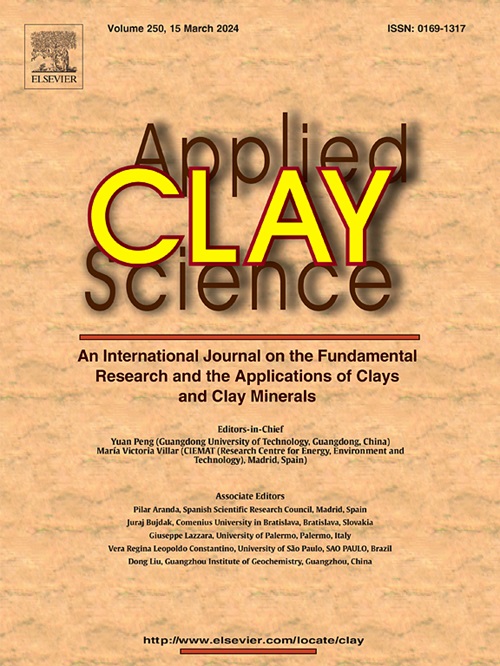Emet, trkiye新近系硼酸盐岩层间泥质沉积物中英辉石及混合层-伊利石/英辉石的赋存状态及成因
IF 5.8
2区 地球科学
Q2 CHEMISTRY, PHYSICAL
引用次数: 0
摘要
富锂粘土岩形成于安那托利亚西部Emet硼酸盐岩矿床中新世火山-沉积单元内。本研究发现了具有技术和经济潜力,但至今未被研究过的英辉石和富含伊辉石/英辉石的混层粘土岩。该粘土岩是在干旱气候条件下,由流纹岩和沸石凝灰岩单元成岩蚀变而成。母岩包括蚀变、绢云母化的斜长石和斜纹石、混浊、绿泥化的黑云母/白云母、沸石、石英和由泥化、绢云母化和碳化基质胶结的岩石碎片。丰富的辉石蒙脱石和混合层状伊利石/辉脱石伴生有长石、石英、局部方解石/白云石、石膏和雄黄。富含辉长岩的粘土岩中Li浓度最高达2200ppm,凝灰岩单元中Li浓度最高达218ppm。蒙脱石薄片与伊利石纤维、长石和角闪孔伴生。硅石、斜长石、黑云母/白云母和角闪石的降解使SiO2与Al2O3、K2O、TiO2和总稀土元素(ΣREE)与SiO2、Al2O3和K2O呈正相关;MgO与Li值,MgO + CaO、Li、Sr + Rb和ΣREE值以及LREE/HREE比值的增强;负Eu异常和高浓度的S和As。这些物理化学成分有利于英辉石和混合层-伊利石/英辉石的形成。辉辉石和混合层-伊利石/辉辉石样品的δD值和δ18O值以及地层温度在98 ~ 119℃范围内反映了埋藏成岩蚀变过程。方解石样品的δ18O和δ13C值显示了淡水和热水的混合作用。方解石和石膏的高87Sr/86Sr比值反映了蚀变过程中Sr的消耗。此外,雄黄和雌二醇的负δ34S值表明它们是在酸性中性条件下通过硫酸盐还原或微生物循环形成的。本文章由计算机程序翻译,如有差异,请以英文原文为准。
Occurrence and genesis of hectorite and mixed-layer-illite/hectorite in argillaceous sediments interlayered with Neogene borate deposits, Emet, Türkiye
The Li-rich claystone was formed within the Miocene volcano-sedimentary units in Emet borate deposits, in western Anatolia. This research identified hectorite and mixed-layer-illite/hectorite-abundant claystone that have technological and economic potential and have not been studied to date. The claystone was formed through the diagenetic alteration of rhyolitic and zeolitic tuffaceous units in a shallow lacustrine playa lake environment under arid climatic conditions. The parent rocks comprise altered and sericitized plagioclase and sanidine, opacited and chloritized biotite/muscovite, zeolite, quartz, and rock fragments cemented by argillizied, sericitized, and carbonatized matrix. Abundant hectoritic smectite and mixed-layer-illite/hectorite accompanied by accessory feldspar, quartz, locally calcite/dolomite, gypsum, and orpiment/realgar. The Li concentration reaches a max of 2200 ppm in the hectorite-abundant claystone and 218 ppm in the tuffaceous units. Smectite flakes are associated with illite fiber, feldspar, and amphibole. The degradation of sanidine, plagioclase, biotite/muscovite, and hornblende contributed to the positive correlation of SiO2 vs. Al2O3, K2O, TiO2, and total rare-earth elements (ΣREE) vs. SiO2, Al2O3, and K2O; MgO vs. Li values, and enhancement of MgO + CaO, Li, Sr + Rb, and ΣREE values, and LREE/HREE ratio; negative Eu anomaly and high concentration of S and As. These physicochemical compositions favored the formation of hectorite and mixed-layer-illite/hectorite. The δD and δ18O values of hectorite and mixed-layer-illite/hectorite samples and the formation temperatures range from 98 to 119 °C reveal a burial diagenetic alteration process. The δ18O and δ13C values of the calcite samples suggest the mixing of thermal and fresh waters. The high 87Sr/86Sr ratios of calcite and gypsum reveal the consumption of Sr during the alteration processes. Additionally, the negative δ34S values of realgar and orpiment suggest formation under acidic-neutral conditions via sulfate reduction or microbial cycling.
求助全文
通过发布文献求助,成功后即可免费获取论文全文。
去求助
来源期刊

Applied Clay Science
地学-矿物学
CiteScore
10.30
自引率
10.70%
发文量
289
审稿时长
39 days
期刊介绍:
Applied Clay Science aims to be an international journal attracting high quality scientific papers on clays and clay minerals, including research papers, reviews, and technical notes. The journal covers typical subjects of Fundamental and Applied Clay Science such as:
• Synthesis and purification
• Structural, crystallographic and mineralogical properties of clays and clay minerals
• Thermal properties of clays and clay minerals
• Physico-chemical properties including i) surface and interface properties; ii) thermodynamic properties; iii) mechanical properties
• Interaction with water, with polar and apolar molecules
• Colloidal properties and rheology
• Adsorption, Intercalation, Ionic exchange
• Genesis and deposits of clay minerals
• Geology and geochemistry of clays
• Modification of clays and clay minerals properties by thermal and physical treatments
• Modification by chemical treatments with organic and inorganic molecules(organoclays, pillared clays)
• Modification by biological microorganisms. etc...
 求助内容:
求助内容: 应助结果提醒方式:
应助结果提醒方式:


